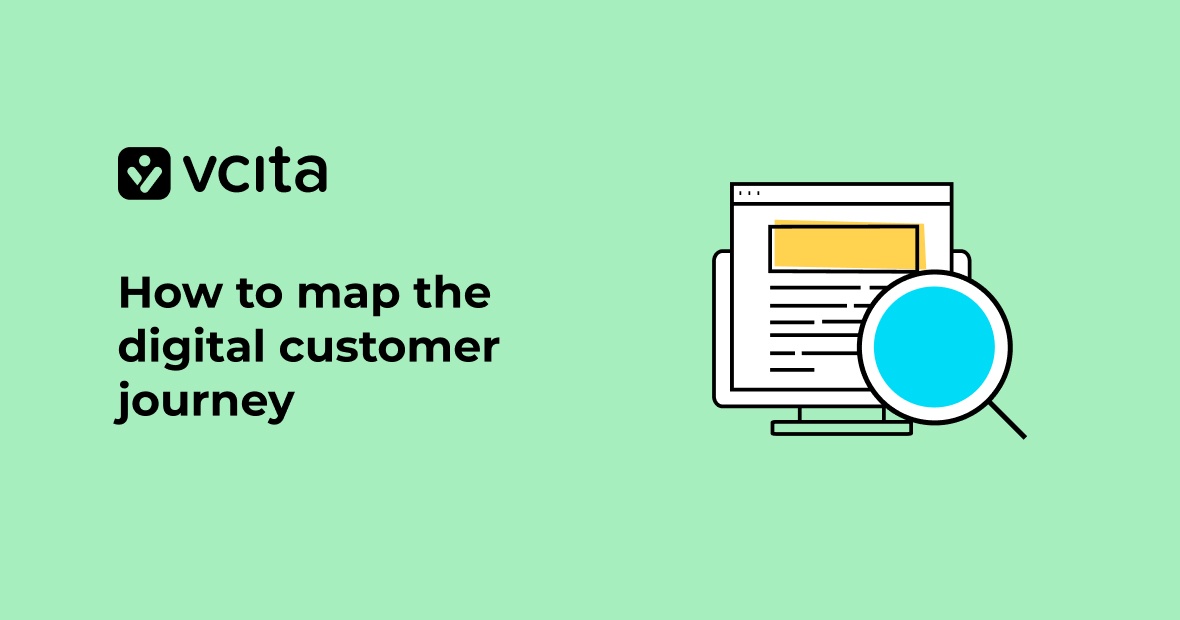Have you ever wondered how your customers find you, choose your business, and become loyal patrons? Creating a customer journey map allows you to see the digital path customers take to discover, engage with, and buy from your company, so you can understand your customers’ journey. This insight is critical for any small service business today.
By mapping the key interactions at each stage, you’ll gain insights into their pain points, priorities, and preferences. You’ll be able to refine your marketing strategies, improve the customer experience, and deliver the high-quality customer service today’s customers expect. Knowing how customers journey through the digital world will set you up for success.
Understanding the digital customer journey
The customer journey means all the online and offline touchpoints a customer has with your business. When you map the customer journey, you track the path they take from first hearing of your business to becoming paid customers of your product or service. On the way, you’ll collect valuable data about how and when your customers interact with your brand. This enables you to identify their pain points and needs at each stage of the journey, so you can improve the overall customer experience.
Some key steps in mapping the digital customer journey include:
- Identifying customer personas and getting to know their behaviors, motivations, and goals. Group them into segments to better understand their unique needs.
- Mapping how a customer interacts with your business at each touchpoint, seeing your website through their eyes and noting places where they struggle or drop off.
- Analyzing where customers come from and how they find you, so you can focus your marketing strategies on the most effective channels for reaching your audience.
- Looking for opportunities to optimize the user experience by removing friction and pushing the information they need at the right time.
- Continuously improving by listening to customer feedback and reviewing analytics.
Identifying customer pain points
Creating a memorable digital customer experience is key to winning loyal customers and growing your small business. The best place to start is by mapping out your customers’ pain points at each stage of their journey. Here are some of the tasks you’ll need to complete to get a full understanding of the ways to improve your customer experience.
-
Talk to your customers
The most effective way to understand your customers is by simply talking to them. Send out surveys and questionnaires to gather feedback on their experiences interacting with your brand, and interview customers and your sales and support teams to understand what’s working and what’s not. Look for common themes in the responses to pinpoint major pain points.
-
Identify your customer personas
As you get information about your customers needs, concerns, preferences, and shopping habits, you can start to create Ideal Customer Profiles (ICPs). These are detailed descriptions of your target customer. Include details like their age demographic, where they live, how often they shop, whether they are more motivated by price, flexible timing, or a sense of exclusivity, and more.
-
Map the customer journey
At the same time as building your ICP, you also need to follow the path that customers take, from first interacting with your brand through purchase and use of your product or service. Note down every touchpoint, like responding to your post on social media, visiting your website, opening an email or SMS from your business, booking an appointment, arriving at your business or meeting your employee, and more. Include interactions like asking questions from customer support, and even making complaints or returning an item.
-
Take note of pain points that customers encounter
As you track the customer journey, mark the pain points you uncover on your new customer journey map. Look for gaps in service or areas of frustration, like a payment process with too many fields, a broken link to your Contact Us page, or confusing information about what’s included in your service bundles.
Improving interactions with your business
Improving customer interactions at each stage of the journey is key to creating loyal customers and a great user experience. Now that you’ve mapped the customer journey and made a note of every pain point, it’s time to take action to resolve those pain points and make the customer journey even more enjoyable.
Improve customer service
Customer support interactions are a major point of friction, and something that many small businesses struggle with. Make your customer service stand out in all the right ways by showing empathy, addressing complaints honestly, and solving problems quickly, to build loyalty by exceeding their expectations. Make it easy for customers to contact you through live chat, social media, phone, and email, and respond in real time whenever possible.
Focus on high-impact issues
Not all pain points are equal, so start by changing the ones that will have the biggest impact on improving the overall customer experience. For example, if long wait times, confusing pricing, or a dated website come up a lot in customer pain points, that’s where you should begin. Even small changes can go a long way toward creating happy, loyal customers.
Optimize the digital experience
Your website and social media profiles are often the first touchpoints in the customer journey, so ensure a seamless user experience by making your content easy to find and navigate. Make sure that all your links work, use clear CTAs (Calls To Action), and keep forms as short and as clear as possible.
Continue improving
Customer journeys are constantly evolving, so make enhancing the customer experience an ongoing process. Monitor how your customers interact with and perceive your business, and look for new ways to enhance their experience through personalization, loyalty programs, and marketing strategies tailored to their needs. Update your customer journey maps regularly to keep up with changes in behavior and new technologies.
Creating seamless customer experiences
Your customers are likely to interact with your business through many channels, including:
- Your business website
- Your Instagram, Facebook, LinkedIn, or other social media account
- Flyers and posters about your business services
- Your email newsletters
- Your office, salon, studio, or professional space
What’s important is that the experience feels seamless no matter which channel your customers use. Use the same logo, color scheme, and tone across your website, social media, emails, and other touchpoints. Product information, services, and pricing should also remain consistent to avoid confusion.
Continuously optimizing the digital customer journey
As customer behaviors and preferences change, as well as your product or service offerings, you need to continuously monitor and improve the customer experience. Some tips for optimizing your digital customer journey:
Monitor analytics
Use analytics tools to pay attention to your customers’ digital experiences in real time. See how they’re engaging with your social posts, blog content, and ads, and track their behavior on your website. Keep a careful eye out for any big changes in metrics like time spent on certain pages, because that could be the sign of a broken link or confusing instruction.
Identify obstacles and frictions
Go through your digital customer journey from the customer’s perspective. Look for any obstacles, confusions or bad user experience that could frustrate customers or cause them to abandon their journey, then work to eliminate these issues. Some examples include a confusing website, broken links, tedious forms, or lack of information.
Test different options to find what’s most effective
Small tweaks can add up to big improvements in the overall digital customer experience, so make changes to improve page load speeds or simplify navigation. Run A/B tests to optimize content, try different headlines, images, or calls-to-action to see which options resonate most, and look at heatmaps to determine the best place to put key information on pages.
Review feedback and data
Pay close attention to customer reviews, comments, and feedback on your website, social media, and review sites. Look for common pain points or issues in the customer journey. You can also analyze data from your website analytics and CRM to see where customers drop off or what they engage with the most. Use this information to make improvements.
Streamline and simplify the customer journey
Make the customer journey as simple, seamless and convenient as possible. Things like auto-fill forms, saved customer information, minimal page redirects, and easy navigation can help. The easier and faster you can make the journey, the more loyal your customers will be.
Personalize the experience
Use the customer data and personas you’ve developed to personalize messaging, offers, and the overall digital experience for your customers. Personalization makes customers feel valued and understood, strengthening your relationship. You can personalize things like:
- Email campaigns and newsletters
- Product or content recommendations on your website
- Blog post topics and social media content
- Discounts, promotions or special offers
A customer journey map could guide your small business to thrive
Mapping your digital customer journey is key to gaining insights that will transform your small business. By creating a customer journey map, you’ll uncover pain points in the user experience and find ways of improving the customer experience at every stage. The future of small business success lies in truly knowing your customers and crafting exceptional customer journeys that turn casual visitors into paying customers, and first-time customers into passionate advocates of your brand. It’s a surefire method to build loyalty and drive success.




























